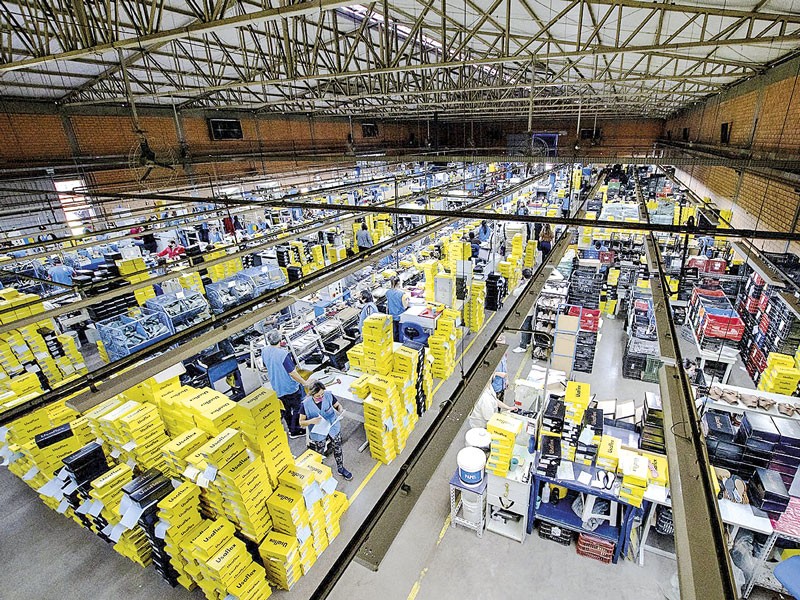


With more than 5,000 footwear factories and nearly 300,000 people employed directly, Brazil's footwear sector is the largest in the Western Hemisphere and the fifth largest in the world, after Asian countries. In the first 11 months of 2024, the national industry created more than 12,500 new jobs.
From January to November 2024, Brazil produced 846 million pairs, representing a 4.6% increase compared to the same period in 2023. Projections for 2025 indicate a rise to 900 million pairs annually.
More than 85% of total production is destined for the domestic market, while the rest is exported to various countries worldwide. In 2024, foreign shipments totaled 97.4 million pairs, valued at US$ 976 million, reflecting a decline of 17.7% in volume and 16.4% in revenue.
Among the primary buyers of Brazilian footwear were the United States, which purchased 10.2 million pairs; Argentina, with 12.6 million pairs; and Paraguay, with 8.3 million pairs. These figures represented a decline of 3.3%, 10.5%, and 20.6% in volume, respectively, compared to 2023.
Regarding imports, 9.8 million pairs arrived from China, 11.8 million from Vietnam, and 6.8 million from Indonesia in 2024. Total imports reached 35.8 million pairs, marking a 26.3% increase compared to the same period in 2023.

Currently, Brazil’s footwear industry is optimistic about increased domestic consumption, which rose by 9% from January to November 2024 compared to the same period in 2023. This growth was driven by declining unemployment and higher household income. During the first three quarters of 2024, Brazil’s GDP grew by 3.3% compared to the same period in 2023. Consequently, household consumption spending increased by 5.1%.
However, regarding exports, the outlook is not very encouraging, due to the state of international conflict caused by geopolitical issues; the slowdown in the global economy, associated with inflation, which reduces purchasing power; the rise in protectionism; and strong competition from Asian producers—all of which are factors that will contribute to the stagnation of demand.
No less important is the evolution of the United States' trade policy, the world's largest market, regarding imports. President Donald Trump has expressed his intention to increase tariffs. In this scenario, restrictions on Chinese products could create more opportunities for Brazilian footwear. However, on the other hand, part of the surplus production from Asia could be redirected to other countries, increasing competition with Brazilian products.
Regarding Argentina, the second-largest buyer, Brazilian manufacturers have renewed their expectations for increasing exports, given the gradual rise in international reserves, which in November were 42% higher than in the same month of 2023.
Other markets analyzed by Brazilian experts include Colombia, which shows sustained demand backed by a projected 2.5% GDP growth for 2025, and Chile, which is also increasing its purchases, making it the largest per capita importer of footwear in the continent.

For all export-related activities, the Brazilian Footwear Industries Association (ABICALÇADOS) receives support from various official entities, primarily the Brazilian Trade and Investment Promotion Agency (APEX). Through the BRAZILIAN FOOTWEAR program, APEX covers 50% of investment costs, with the remaining half funded by participating companies.
During the 2024-2025 biennium, more than U$$ 6 million will be invested in the internationalization and promotion of the Brazilian footwear industry. Key initiatives include participation in international trade fairs, business missions to various countries, and hosting foreign buyers.
Thanks to official support and independent efforts, the Brazilian footwear industry maintains an active presence at major international trade fairs.
One of these was Micam Milano in Italy, held in September 2024, where 76 brands secured US$ 26 million in sales. More recently, Expo Riva Schuh in Riva del Garda, Italy, in January 2025, generated US$ 21 million in sales and projections for 40 footwear brands.
Additionally, a trade mission to Bogotá, Colombia, in the same month, is expected to generate US$ 3.3 million in sales. Meanwhile, in the United States, three fairs -Magic Las Vegas, Atlanta Shoe Market, and Magic NY in New York- will host a significant delegation of manufacturers, with a reference point of 2024, when the northern country bought 10.2 million Brazilian pairs.

In recent years, an interesting process has taken place in Brazil's trade fair market, shifting from a fragmented and scattered offering to a more streamlined agenda with greater representativeness and commercial effectiveness. The focus has been on selecting strategic locations with enhanced service infrastructure and connectivity, facilitating the arrival of both local and international buyers.
The emergence of the oficial fair BFSHOW, which is held by ABICALÇADOS and organized by NürnbergMesse Brasil, has structured the footwear industry’s offerings. In its latest edition in November 2024, it established itself as the largest footwear event in Latin America. The fair brings together Brazil’s leading industries and brands in a highly professional setting, attracting increased interest from buyers of various origins. The next edition will take place in the Anhembi district of São Paulo in May 2025.
A key priority in the Brazilian industry, where suppliers and manufacturers work together toward sustainable production and products that do not compromise the environment or natural resources.
To this end, the two main national entities related to the footwear production chain, ABICALÇADOS and ASSINTECAL (suppliers), have created a single ESG (environment, society, and corporate governance) and sustainability certification, called ORIGEM SUSTENTÁVEL (Sustainable Origin). This certification is based on international best practices and follows 104 indicators distributed across five dimensions: economic, environmental, social, cultural, and sustainability management.
Currently, 102 footwear and component companies participate in the certification program, with 82 already certified.
It is an opportunity to align production processes with internationally recognized indicators, enhancing export market opportunities and driving sustainable growth throughout the entire production chain.
Source and photos: ABICALÇADOS/Brazil